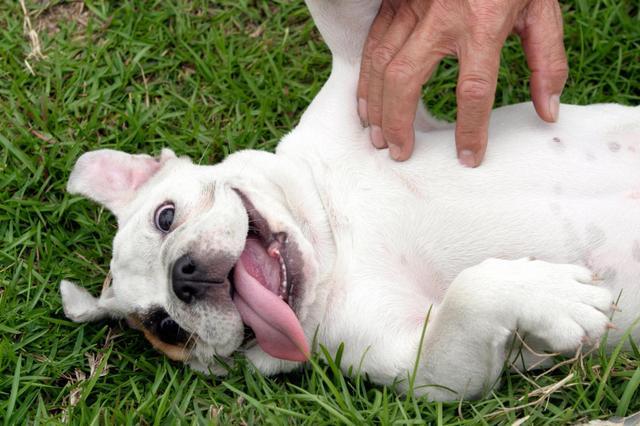Dogs are fascinating creatures with unique behaviors that can sometimes leave their owners scratching their heads. One of the most endearing behaviors is when a dog rolls over and exposes its belly to its owner. This article explores the reasons behind this behavior, what it means, and how owners can respond appropriately.

1. Trust and Submission
The Connection Between Belly Exposure and Trust
When a dog shows its belly, it is often a sign of trust and submission. In the canine world, exposing the belly is a vulnerable position, indicating that the dog feels safe and secure around its owner.
- Trust Signals:
- Dogs that expose their bellies are usually comfortable in their surroundings and trust the people present.
- This behavior is more common in dogs that have formed a strong bond with their owners.
Understanding this behavior is essential for building a solid relationship with your dog.
2. Seeking Attention and Affection
Dogs as Attention Seekers
Another reason dogs show their bellies is to seek attention and affection from their owners. This behavior can be especially common during playtime or when a dog wants to engage with its human.
- Affectionate Behavior:
- When a dog rolls over, it may be inviting belly rubs, which many dogs find pleasurable.
- This action is often accompanied by wagging tails and happy barks, indicating enthusiasm and a desire for interaction.
Recognizing your dog’s signals can enhance your bond and ensure they receive the attention they crave.
3. Comfort and Relaxation
Dogs as Creatures of Comfort
For many dogs, exposing their bellies is simply a comfortable position. When a dog feels relaxed and content, it may roll over onto its back, displaying its belly.
- Signs of Comfort:
- A relaxed dog will often lie on its back with its legs in the air, indicating a state of ease.
- This behavior is common in secure environments where the dog feels at home.
Creating a comfortable space for your dog encourages this behavior and promotes overall well-being.
4. Playfulness and Invitation to Engage
Dogs and Playful Behavior
Exposing the belly can also be an invitation to play. Dogs are playful animals, and rolling over can be part of their playful antics.
- Play Invitation:
- When a dog shows its belly during play, it may be asking for a belly rub or playful interaction.
- This behavior is often seen during games of fetch or tug-of-war when the dog is excited and wants to engage with its owner.
Recognizing these playful cues allows owners to engage with their pets positively and strengthen their bond.
5. Protection Instincts
The Role of Belly Exposure in Canine Behavior
In some cases, dogs may expose their bellies as a protective instinct. This behavior can be seen in more submissive dogs that want to avoid confrontation.
- Submissive Behavior:
- When feeling threatened or unsure, a dog might roll over to show submission and avoid conflict.
- This action serves as a signal to other animals or humans that the dog does not wish to fight.
Understanding this behavior can help owners provide a safe and secure environment for their dogs.
6. Medical Concerns
When Belly Exposure Indicates Health Issues
While belly exposure is often a positive behavior, it can sometimes indicate underlying medical issues. If a dog frequently exposes its belly but shows signs of discomfort, it may be worth consulting a veterinarian.
- Health Indicators:
- Dogs that are unwell may expose their bellies to alleviate pressure or discomfort.
- Watch for additional signs, such as lethargy, changes in appetite, or excessive licking of the belly.
Being attentive to your dog’s behavior can help catch potential health issues early.
7. Reinforcing Positive Behavior
Encouraging Your Dog’s Trust
As a dog owner, it’s essential to reinforce the positive behaviors associated with belly exposure. When your dog shows its belly, respond positively to strengthen your bond.
- Positive Reinforcement Techniques:
- Offer gentle belly rubs and praise when your dog exposes its belly.
- Use treats to reward your dog for displaying trust and affection.
These actions encourage your dog to continue expressing itself and reinforce your relationship.
8. Respecting Boundaries
Understanding When to Stop
While many dogs enjoy belly rubs, not all dogs are comfortable with this interaction. It’s essential to read your dog’s body language and respect their boundaries.
- Recognizing Comfort Levels:
- If a dog pulls away or shows signs of discomfort (like growling or tensing up), it’s crucial to stop.
- Each dog has different preferences, and respecting their boundaries fosters trust.
Being mindful of your dog’s feelings ensures a positive experience for both of you.
9. Socialization and Learning
The Importance of Social Interaction
Socialization plays a critical role in how dogs express themselves. The more socialized a dog is, the more comfortable they may feel in exposing their belly.
- Encouraging Social Behavior:
- Engage your dog with other dogs and people to promote healthy social interactions.
- Positive experiences during socialization can lead to increased trust and affection.
Socialization enhances your dog’s overall confidence and well-being.
10. Conclusion
Understanding why dogs often show their bellies is crucial for every dog owner. This behavior is primarily a sign of trust, seeking affection, and playfulness. By recognizing and responding appropriately to this behavior, you can foster a deeper bond with your furry friend.
Remember that while exposing their belly is generally a positive sign, it’s essential to monitor your dog’s comfort and respect their boundaries. With patience and understanding, you can create a loving and secure environment for your beloved pet.

Comments (0)